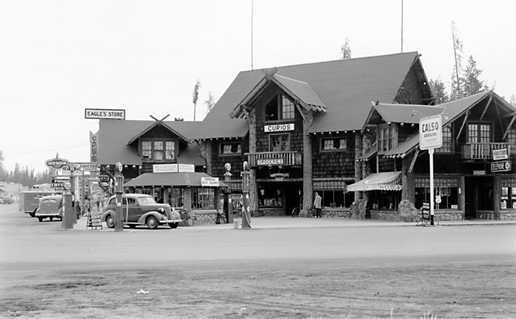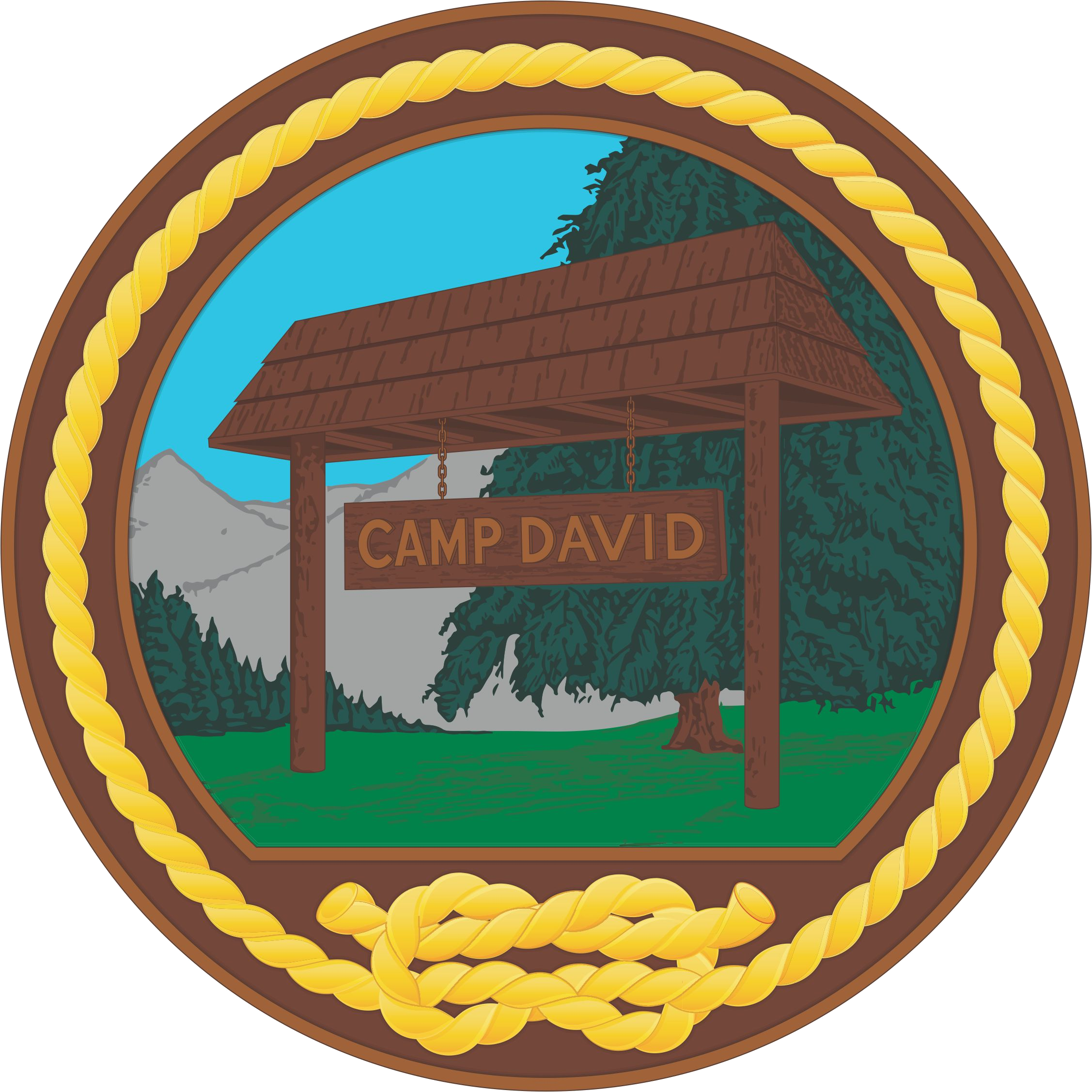|
Camp Greentop Historic District
Camp Greentop is located in Catoctin Mountain Park near Thurmont, Maryland. The camp was built by the Works Progress Administration labor program in the development of what was then known as the Catoctin Mountain Recreational Demonstration Area, and comprises 22 rustic log buildings including sleeping cabins, administrative buildings and lodges. All were built between 1934 and 1938. The buildings are a simplified version of the National Park Service Rustic style. The camp was originally to duplicate the design of Camp Misty Mount, but was modified during construction for use by the Baltimore League for Crippled Children, making it one of the first handicap-accessible facilities in the United States. "From 1957 through 1996, every student in Frederick County enjoyed the opportunity to make a national park their school". Students stayed in the cabins while taking advantage of this outdoor school as part of Frederick County's Outdoor School program. The camp was designed to accom ... [...More Info...] [...Related Items...] OR: [Wikipedia] [Google] [Baidu] |
Thurmont, Maryland
Thurmont is a town in Frederick County, Maryland, United States. The population was 6,935 at the 2020 census. The town is located in the northern part of Frederick County (north of Frederick, the county seat), approximately ten miles from the Pennsylvania border, along U.S. Highway 15. It is very close to Cunningham Falls State Park and Catoctin Mountain Park, the latter of which contains the presidential retreat of Camp David. Thurmont is also home to Catoctin Colorfest, an arts and crafts festival that draws in about 125,000 people each autumn. In 2005, Thurmont was designated as a Maryland Main Street Community and in 2005 Thurmont was designated a National Main Street under the National Trust for Historic Preservation. History Name change Originally incorporated as the Town of Mechanicstown in 1751, the name of the town was changed to Thurmont by an act of Maryland General Assembly on January 18, 1894. This name change was due to several other nearby towns having simil ... [...More Info...] [...Related Items...] OR: [Wikipedia] [Google] [Baidu] |
Catoctin Mountain Park
Catoctin Mountain Park, located in north-central Maryland, is part of the forested Catoctin Mountain ridge−range that forms the northeastern rampart of the Blue Ridge Mountains, in the Appalachian Mountains System. Approximately 5120 acres or in area, the park features sparkling streams and panoramic vistas of the Monocacy Valley. Catoctin Mountain Park is managed by the National Park Service, and lies north of and directly adjacent to the similarly-sized Cunningham Falls State Park. History In the 1930s, after years of making charcoal to fuel nearby iron furnaces, mountain farming, and harvesting of trees for timber, land was purchased to be transformed into a productive recreation area, helping to put people back to work during the Great Depression. Beginning in 1935, the Catoctin Recreational Demonstration Area was under construction by both the Works Progress Administration and the Civilian Conservation Corps. The northern portion of the park was transferred to the Na ... [...More Info...] [...Related Items...] OR: [Wikipedia] [Google] [Baidu] |
Works Progress Administration
The Works Progress Administration (WPA; renamed in 1939 as the Work Projects Administration) was an American New Deal agency that employed millions of jobseekers (mostly men who were not formally educated) to carry out public works projects, including the construction of public buildings and roads. It was set up on May 6, 1935, by presidential order, as a key part of the Second New Deal. The WPA's first appropriation in 1935 was $4.9 billion (about $15 per person in the U.S., around 6.7 percent of the 1935 GDP). Headed by Harry Hopkins, the WPA supplied paid jobs to the unemployed during the Great Depression in the United States, while building up the public infrastructure of the US, such as parks, schools, and roads. Most of the jobs were in construction, building more than 620,000 miles (1,000,000 km) of streets and over 10,000 bridges, in addition to many airports and much housing. The largest single project of the WPA was the Tennessee Valley Authority. At its peak ... [...More Info...] [...Related Items...] OR: [Wikipedia] [Google] [Baidu] |
National Park Service Rustic
National Park Service rustic – sometimes colloquially called Parkitecture – is a style of architecture that developed in the early and middle 20th century in the United States National Park Service (NPS) through its efforts to create buildings that harmonized with the natural environment. Since its founding in 1916, the NPS sought to design and build visitor facilities without visually interrupting the natural or historic surroundings. The early results were characterized by intensive use of hand labor and a rejection of the regularity and symmetry of the industrial world, reflecting connections with the Arts and Crafts movement and American Picturesque architecture. Architects, landscape architects and engineers combined native wood and stone with convincingly native styles to create visually appealing structures that seemed to fit naturally within the majestic landscapes. Examples of the style can be found in numerous types of National Park structures, including entrance ga ... [...More Info...] [...Related Items...] OR: [Wikipedia] [Google] [Baidu] |
Camp Misty Mount Historic District
Camp Misty Mount is located in Catoctin Mountain Park near Thurmont, Maryland. The camp was built by the Works Progress Administration labor program in the development of what was then known as the Catoctin Mountain Recreational Development Area, and comprises 35 rustic log buildings including sleeping cabins, administrative buildings and lodges. All were built between 1935 and 1938. The buildings are a simplified version of the National Park Service Rustic style. Misty Mount is used as a public cabin-camping facility. Misty Mount is also known as Camp 1: Camp 2 is Camp Greentop and Camp 3, originally called Camp Hi-Catoctin and located at a much higher elevation, became Camp David. Camp Misty Mount Historic District was listed on the National Register of Historic Places The National Register of Historic Places (NRHP) is the United States federal government's official list of districts, sites, buildings, structures and objects deemed worthy of preservation for their hi ... [...More Info...] [...Related Items...] OR: [Wikipedia] [Google] [Baidu] |
Camp David
Camp David is the country retreat for the president of the United States of America. It is located in the wooded hills of Catoctin Mountain Park, in Frederick County, Maryland, near the towns of Thurmont and Emmitsburg, about north-northwest of the national capital city of Washington, D.C.Frequently Asked Questions . Catoctin Mountain Park, Retrieved on February 4, 2011. "10. Where is Camp David? The Presidential Retreat is within the park however, it is not open to the public and its location is not shown on our park maps for both security and privacy. If you're interested in historical information, visit our Presidential Retreat webpage." It is officially known as the Naval Support Facility Thurmont. Because it is technic ... [...More Info...] [...Related Items...] OR: [Wikipedia] [Google] [Baidu] |
National Register Of Historic Places
The National Register of Historic Places (NRHP) is the United States federal government's official list of districts, sites, buildings, structures and objects deemed worthy of preservation for their historical significance or "great artistic value". A property listed in the National Register, or located within a National Register Historic District, may qualify for tax incentives derived from the total value of expenses incurred in preserving the property. The passage of the National Historic Preservation Act (NHPA) in 1966 established the National Register and the process for adding properties to it. Of the more than one and a half million properties on the National Register, 95,000 are listed individually. The remainder are contributing resources within historic districts. For most of its history, the National Register has been administered by the National Park Service (NPS), an agency within the U.S. Department of the Interior. Its goals are to help property owners and inte ... [...More Info...] [...Related Items...] OR: [Wikipedia] [Google] [Baidu] |
Historic Districts In Frederick County, Maryland
History (derived ) is the systematic study and the documentation of the human activity. The time period of event before the invention of writing systems is considered prehistory. "History" is an umbrella term comprising past events as well as the memory, discovery, collection, organization, presentation, and interpretation of these events. Historians seek knowledge of the past using historical sources such as written documents, oral accounts, art and material artifacts, and ecological markers. History is not complete and still has debatable mysteries. History is also an academic discipline which uses narrative to describe, examine, question, and analyze past events, and investigate their patterns of cause and effect. Historians often debate which narrative best explains an event, as well as the significance of different causes and effects. Historians also debate the nature of history as an end in itself, as well as its usefulness to give perspective on the problems of the p ... [...More Info...] [...Related Items...] OR: [Wikipedia] [Google] [Baidu] |




.jpg)